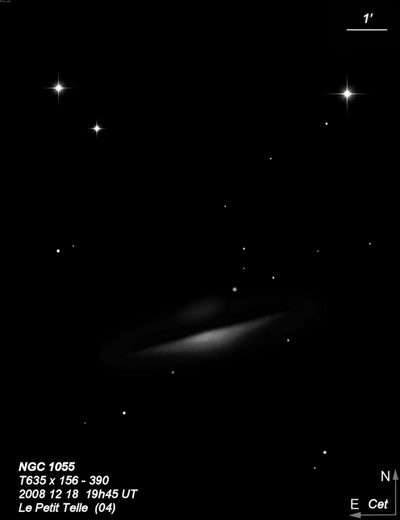
William Herschel discovered NGC 1055 = H I-1 = H II-6? = h258 on 19 Dec 1783 (early sweep 53?). His summary description (based on 7 observations) reads "cB, cL, iF, bM." He possibly found NGC 1055 the night before, noting H II-6 as "a small nebula. It is like a very small comet, not visible in the finder 1/2?." He estimated the position as roughly 1/2? north of Delta Ceti and later commented "This has probably been a telescopic comet, as I have not been able to find it again, notwithstanding the assistance of a drawing which represents the telescopic stars in its neighbourhood." In the 1912 revision of WH's catalogues, Dreyer suggested H. II 6 was equivalent to NGC 1055 and added the note "very rough sketch shows it in line with 2 stars preceding and one following." Steinicke, though, equates H. II 6 with a pair of stars at 02 40 19.5 +00 54 37 (2000), which fits Dreyer's comments.
200/250mm - 8" (11/8/80): faint, elongated. Located 30' NNW of M77.
300/350mm - 13" (9/3/83): fairly faint, elongated WNW-ESE. A mag 12 star is 1' N.
400/500mm - 17.5" (11/14/87): fairly bright, fairly large, very elongated 3:1 WNW-ESE, broadly concentrated halo. A mag 11 star is just off the NW flank 1.2' from the center. Located 7' SE of mag 6.8 SAO 110689 and 7' SW of mag 7.8 SAO 110692. Member of the M77 group.
900/1200mm - 48" (10/24/14): very bright, nearly edge-on spiral, spans ~6'x1.8' WNW -ESE. The bright central region extends 2'x0.5' and increases gradually towards the center. A relatively wide, prominent dust lane runs along nearly the entire northern flank of the galaxy!
The fainter portion of the galaxy on the north side of the dust lane was clearly visible paralleling the central region. Due to a slight tilt in edge-on orientation, the northern section of the galaxy is partially obscured and extended only ~1.6' in length and at most 30" in width. The glow terminates on its west side after reaching the mag 11.2 star just 1.2' NNW of center. Forms a wide pair (similar radial velocity) with M77 30' SSE.
Notes by Steve Gottlieb